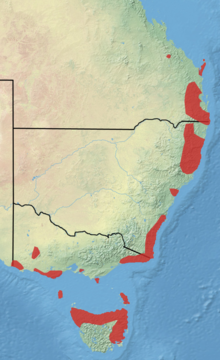
Back Bisovol (Potorous tridactylus) AVK پوتوروس تریداکتیلوس AZB Дългоносо потору Bulgarian Cangur rata de musell llarg Catalan Potorous tridactylus CEB Klokánek krysí Czech Langschnauzen-Kaninchenkänguru German Potorous tridactylus Spanish Potorous tridactylus Basque کانگوروی خرگوشی بینیدراز Persian
| Long-nosed potoroo[1] | |
|---|---|

| |
| Long-nosed potoroo in Tidbinbilla Nature Reserve, ACT, Australia | |
| Scientific classification | |
| Domain: | Eukaryota |
| Kingdom: | Animalia |
| Phylum: | Chordata |
| Class: | Mammalia |
| Infraclass: | Marsupialia |
| Order: | Diprotodontia |
| Family: | Potoroidae |
| Genus: | Potorous |
| Species: | P. tridactylus
|
| Binomial name | |
| Potorous tridactylus | |
| Subspecies | |

| |
| Distribution of the long-nosed potoroo | |
The long-nosed potoroo (Potorous tridactylus) is a small, hopping mammal native to forests and shrubland of southeastern Australia and Tasmania. A member of the potoroo and bettong family (Potoroidae), it lives alone and digs at night for fungi, roots, or small insects. It is also a marsupial (like kangaroos) and carries its young in a pouch. The long-nosed potoroo is threatened by habitat loss and introduced species such as cats or foxes. There are two subspecies: P. t. tridactylus on mainland Australia, and P. t. apicalis on Tasmania, with lighter fur.[4]
At first glance, the long-nosed potoroo with its pointed nose and grey-brown fur looks very much like a bandicoot — that is, until it hops away with its front feet tucked into its chest, revealing its close relationship with the kangaroo family. The long-nosed potoroo exhibits many morphological specializations such as an elongated pointed rostral region (nose), erect ears, large eyes, claws for digging, and long robust hind legs.[5] It is only a small marsupial, with a body length between 34 and 38 cm (13–15 in), and a semi-prehensile tail length of 15 to 24 cm (5.9–9.4 in).[6]
As it is rarely seen in the wild, better indicators of its presence are the runways it makes through the undergrowth and the hollow diggings it leaves behind when feeding on underground roots and fungi.
- ^ Groves, C. P. (2005). Wilson, D. E.; Reeder, D. M. (eds.). Mammal Species of the World: A Taxonomic and Geographic Reference (3rd ed.). Baltimore: Johns Hopkins University Press. p. 58. ISBN 0-801-88221-4. OCLC 62265494.
- ^ Woinarski, J.; Burbidge, A.A. (2020). "Potorous tridactylus". IUCN Red List of Threatened Species. 2020: e.T41511A166499137. doi:10.2305/IUCN.UK.2020-1.RLTS.T41511A166499137.en. Retrieved 13 November 2021.
- ^ Linné, Carl von; Archer, J.; Gmelin, Johann Friedrich; Kerr, Robert (1792). The animal kingdom, or zoological system, of the celebrated Sir Charles Linnæus. containing a complete systematic description, arrangement, and nomenclature, of all the known species and varieties of the mammalia, or animals which give suck to their young. Vol. 1. Printed for A. Strahan, and T. Cadell, London, and W. Creech, Edinburgh.
- ^ a b Norton 2010
- ^ Seebeck 1981
- ^ "1". The Illustrated Encyclopædia of Animals (1st ed.). London: Marshall Publishing. 1998. p. 31. ISBN 1-84028-087-5.
© MMXXIII Rich X Search. We shall prevail. All rights reserved. Rich X Search
